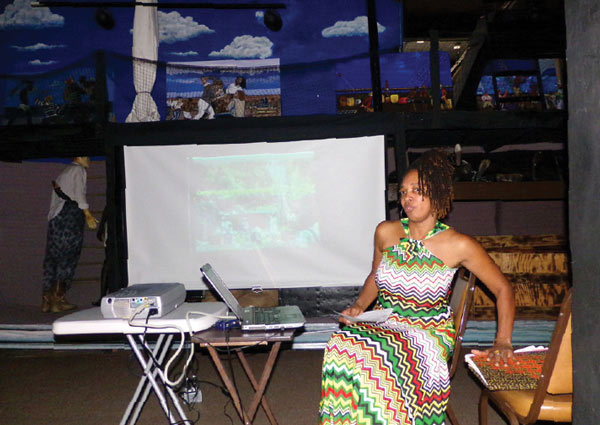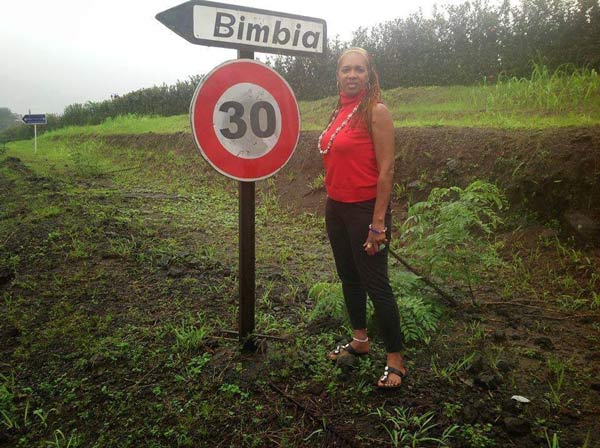Names like Goree (Senegal), Bunce Island (Sierra Leone), Elmina (Ghana) and Ouidah (Benin) are all synonymous to the Transatlantic Slave Trade, and have gained an iconic place in history as locations from whence millions of Africans (up to 15 million it is believed) were transported to Europe and the Americas to be sold as slaves. How about the island of Bimbia? Have you ever heard of her?
Dr. Lisa Aubrey is an associate professor of African American Studies and Political Science at Arizona State University. She is also a Fulbright scholar (2014-15) based at the University of Yaounde I.
Since 2010, Dr Aubrey has been conducting research on Bimbia, a supposedly forgotten or not so often talked about slave trade port she refers to as “The Apertura”, located in the South West region of the central African nation of Cameroon. “It is the site at which African ethnicities in Cameroon were forcibly and cruelly whisked away from their homeland, or killed,” says Dr Aubrey in a recent special edition of Villages D’Afrique magazine. She goes on to note that the Transatlantic Slave Trade on the coast of Cameroon took place between the mid-17th to late 19th century. Dr Aubrey’s research team (between September 2010 and July 2014) were able to locate and validate some 166 slave ship voyages that left Cameroon bound mostly for plantations in the Americas, sometimes via neighboring Equatorial Guinea. “Bimbia is opening the door for broader research,” says the Louisiana, USA native.
This past September, I attended Dr Lisa Aubrey’s Exposing Bimbia presentation in Atlanta, at the Apex Museum. As a Cameroonian, I was curious about information Dr Aubrey and her team were uncovering. Mainly because I, like many of my compatriots, had little awareness on the significance of Bimbia in the Transatlantic Slave Trade. Although I had often wondered why many African Americans (most notably Quincy Jones, Don Cheadle, Spike Lee, Chris Rock, Common, Erykah Badu, Anthony Anderson, Taraji Henson, Blair Underwood, Chris Tucker, Congressmember Karen Bass, and more), tracing their ancestral roots back, were finding DNA links to Cameroon.
It was heartbreaking to learn that my village in Wum (Menchum Division, North West region) was named amongst the areas in Cameroon where Africans had been taken.
For these reasons and more, such research as Dr Aubrey’s is crucial in piecing together a significant and ever present past – a painful history of huge vitality morally, spiritually and even economically – for both Cameroon (and the African continent in general) and descendants of Africans whose ancestors possibly embarked from Bimbia’s shores on a journey of no-return…until now.

Exposing Bimbia presentation by Dr Lisa Aubrey & Alain Kenfack of Villages D’Afrique Magazine in Atlanta at the Apex Museum. September 15, 2015
DUNIA Magazine: In your time in Bimbia, what has the interaction with the indigenous population been like? Are they mindful of their history or they are unaffected by it?
Dr Lisa Aubrey: The populations are several, if I can speak about it his way. The Bimbia community, not far from the site, is very welcoming. I have established a relationship with the community. They look for me, support me, and encourage me—and give me coconuts, avocados, bananas, groundnuts, love, etc. It’s become a ritual. They have as many questions about my curiosity and about the African Diaspora as I have about Bimbia and the history.
The political authority—the Mayor and the Limbe III Council—and I have a good working relationship. They are locating more structures that have been buried in the forest. They have formulated wonderful and relevant projects for the perpetuity of the site in a way that is respectful of community, environment, history, and culture.
The traditional authority is also quite welcoming and encouraging. And of course, we know that nothing will move in the correct way if the traditional authority does not bless it.
Civil society is also quite excited about what is going on at Bimbia and about linking the present to the past, and using the past to plan for the future. And women’s groups are telling me to keep pressing on.
Overall, what the various groups and individuals know about the Bimbia past is patchy and relevant, and I completely understand this given that Bimbia has been hidden from us for so long. I am using this opportunity to put the pieces together. All are affected and have a desire to know, and are willing to share. This is a blessing.
Village d’Afrique magazine on Bimbia covers many of the perspectives of these various groups, and various individuals.
Research of such consequence, one would imagine, would necessarily involve administrative and socio-political maneuverings. How much skin has the government of Cameroon put in the game to support the research?
Dr Lisa Aubrey: There has been no financial support from the Cameroon government or civil society groups for my research to date.
I believe, however, that as Bimbia becomes better known as a historic site, a spiritual site, a sanctuary, a potential tourist attraction with immense possibilities, that resources will come. When it’s also understood how much research and preservation needs to be done on this historic treasure that is larger than any other site of its kind in Africa, resources will come.
I must say that there is a lot of growing interest in Bimbia in Cameroon, even though support has not yet flowed for my research. I am hopeful. The US government through the US Embassy in Cameroon has provided a seed grant of just over $76,000 not to me, but to the Cameroon government and a Cameroon civil society group to begin some work. That was in 2012. And the Ministry of Culture, with my assistance, in May 2013 secured an official designation for Bimbia as a National Cultural Heritage Site. The US Fulbright Program is now supporting my introduction of a course at University of Yaounde I on Bimbia in the context of Cameroon and the Transatlantic Slave Trade, as well as other courses related to Bimbia and my research.
I’m hopeful.
What has surprised you the most along this journey, both from a personal perspective of an African American reconnecting with her African brothers and sisters and as a professional that is uncovering part of a painful past?
Dr Lisa Aubrey: What surprised me the most is Cameroonians telling me about stories of their family members who were taken away in the apocalypse. Some have told me that they have never talked about this family history in public before. Some indicate that they still hold rituals for their family members that were taken away. Others know histories of family members who were killed in the apocalypse. The untold history is rising.
What also surprised me is that some in Cameroon have asked me to “just leave this alone.”
It is “Silly Season” in US politics and Republican presidential runner, Dr Ben Carson is quoted to have said that “slavery is the best thing that could have happened to us (African Americans) … because if it were not for slavery we would all be in Africa, hanging on trees and worshipping Allah”. How do these stereotypical statements build or break down walls between Africans and African Americans?
Dr Lisa Aubrey: First, I think that Ben Carson does not represent the majority attitude of African Americans toward Africa. His extreme view about Africa does not deviate from this other political stances that he is articulating, which many African Americans are not embracing. Second, Ben Carson has traced this roots back to Africa. The statement you cite makes one wonder why he would take time to trace his roots. Third, his statement does not bode well for the reconnection of Global Africa, but it does illustrate that there is not a monolithic African American view about Africa. It is likewise the case about an African view or a Cameroonian view toward African Americans—it is not monolithic. We have a complicated history that is most often not told by us. Recovering our history from Afrocentric perspective can be one way to challenge negative views and lies about Africa.
Regarding your research on the Bimbia, where would interested readers look forward to reading your published work and how soon will that be?
Dr Lisa Aubrey: For how I got involved and immersed in this research and my initial findings, interested readers can check out Lisa Aubrey “Exposing Cameroon’s Connection to the Transatlantic Slave Trade” in Annales de la Faculte des Arts, Lettres and Sciences Humaines: Culture et Developpement, No. 15, Nouvelle Series 2013, University of Yaounde I, pp. 193-221.
For my extensive discussion on Bimbia and the list of slave ships from the Cameroon territory unearth thus far with related data, interested readers can check out Lisa Aubrey “Cameroon, the Transatlantic Slave Trade, and Bimbia the Apertura:Research Findings of 166 Slave Ship Voyages And Their Disembarkations” at https://www.cameroonweb.com/CameroonHomePage/features/artikel.php?ID=310976 and https://www.icameroon.com/2014/09/cameroon-and-the-transatlantic-slave-trade-a-list-of-166-slave-voyages/ and https://www.scribd.com/doc/239111924/Cameroon-and-the-Transatlantic-Slave-Trade.
For a pictorial presentation, interested readers can check out Lisa Aubrey and Alain Kenfack, Bimbia: Le Chemin de la Reconciliation/Route to Re-Memory and Reconnection, Village d’Afrique, Special Bilingual Edition.
Another forthcoming book chapter is Lisa Aubrey, “DNA Technology, New York’s African Burial Ground, and Tracing Roots of the Historic African Slavery Diaspora: With Links to Cameroon, Central Africa and Bimbia” in Daniel Abwa’s Rewriting the history of Cameroon for Cameroonians. Book to be out soon.
Interested readers can also have a look at exposingbimbia.blogspot.com.
There are also a host of articles and youtube videos about my work. Much more is in the pipeline and will be out very soon.
Dr Aubrey, are there core values from your upbringing that prepared you for this moment and the research that you are currently carrying out?
Dr Lisa Aubrey: I am from Louisiana in the United States, from a village that is called LaPointe in the bayous. I did not realize while growing up how different Louisiana is from other parts of the US and just how African Louisiana remains in terms of food, culture, music, and general ways of being. As a dimension of my research, I am tracing Cameroon ethnicities brought to Louisiana as enslaved persons and have identified at least 10 ethnic groups so far. Among them are Bamun, as well as someone from the Diboumbari area not far from Douala, and also another from near the Limbe area. This research is very exciting and rewarding, and is helping us to root and reconnect with our original selves as well as with each other.
So yes, some values that prepared me for this work include a strong sense of family, community, cooperation, along with a belief in truth and justice. I was also instilled with a work ethic that we don’t stop until it is satisfactorily done. All of this, with a very curious mind gives me the drive to press on, as well as knowing that this is part of my life’s mission and my life’s work. Deep spiritualty also resides at my core.
Finally, talk to us on a lighter note about your favorite African cuisines and the music that you most love to listen and dance to?
Dr Lisa Aubrey: Wow, this is the beginning of another long interview! I love African cuisines from all regions of the continent and from the Diaspora–Brazil, Jamaica, Grenada, Guyana, Louisiana….. I could go on!
Music is the same from zyco, to R&B, to jazz, to salsa, to makossa, to tarabu, to ska, to calypso, to reggae–contemporary and classics, I love it!!! And dancing, we can with Ambasie Bay and move to crunkl! Let’s have some music next time……
>> VIEW PICTURES OF EXPOSING BIMBIA PRESENTATION IN ATLANTA

The BIMBIA CULTURAL HERITAGE SITE is managed by LIMBE III Council.
(Interview by Lema Abeng | Twitter @LemaAbeng, and with contribution from Innocent Chia | Twitter @InnoChia)

Great research work there, Ms Aubrey! Interesting to learn that Bimbia was actually a big departure site for slaves leaving for the Americas. Thanks, Dunia Magazine, for giving us a glimpse into Lisa’s work.